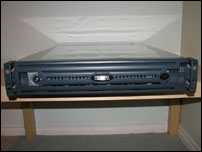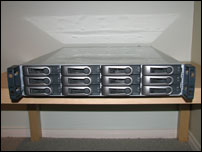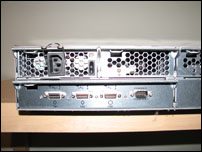Promise VTrak J300s
by Jason Clark & Dave Muysson on February 2, 2007 8:00 AM EST- Posted in
- IT Computing
The Promise VTrak J300s
Promise has long been known for their involvement in the storage industry. If you can remember back to the early nineties (Ed: sorry if that makes some of you feel old...), Promise was making VESA EIDE accelerator cards. Maybe unknown to some are their VTrak products targeted at the small to enterprise storage consumer. They have iSCSI SAN solutions and a range of Direct Attached solutions like the VTrak J300s that we're evaluating in this article.
The VTrak J300s is a 2U 12 drive RAID/JBOD solution capable of housing either SAS or SATA drives. It has the ability to daisy chain up to three additional chassis off the expansion port on the rear of the device. This would give you a total capacity of 24 TB when using 500GB SATA drives.
Each chassis has three 3 Gbit SAS 4x ports, two host ports and one expansion port for cascading the chassis together. If you're wondering what 4x ports are, it is another way to describe a wide port. As we discussed earlier in the article a wide port is made up over several links, in this case 4 links each with 3Gbit of bandwidth, which means that the 4x (wide port) is capable of 12 Gbit/sec of overall bandwidth.
Users can purchase an additional I/O module for redundancy, which also has three 3 Gbit 4x ports. Promise took reliability quite seriously with this unit; with redundant I/O, power, cooling, and monitoring there is no single point of failure. At the rear of the unit there is also a serial port that allows the administrator to use the Command Line Interface (CLI) and monitor the device remotely.
Management of the J300s was fairly simple and straightforward. The chassis and drives were identified by the RAID controller without any issue, including the Windows driver for the chassis. The CLI gives you access to a number of things such as fan speeds, voltages, temperature, SAS addresses, phy status, error counters, etc. It also lists vital product data for field replaceable units, current firmware version, uptime, and thermal management control. We found the CLI to be easy to navigate, and complete documentation is provided on its use.
Promise has long been known for their involvement in the storage industry. If you can remember back to the early nineties (Ed: sorry if that makes some of you feel old...), Promise was making VESA EIDE accelerator cards. Maybe unknown to some are their VTrak products targeted at the small to enterprise storage consumer. They have iSCSI SAN solutions and a range of Direct Attached solutions like the VTrak J300s that we're evaluating in this article.
 |
 |
| Click to enlarge | |
The VTrak J300s is a 2U 12 drive RAID/JBOD solution capable of housing either SAS or SATA drives. It has the ability to daisy chain up to three additional chassis off the expansion port on the rear of the device. This would give you a total capacity of 24 TB when using 500GB SATA drives.
 |
 |
| Click to enlarge | |
Each chassis has three 3 Gbit SAS 4x ports, two host ports and one expansion port for cascading the chassis together. If you're wondering what 4x ports are, it is another way to describe a wide port. As we discussed earlier in the article a wide port is made up over several links, in this case 4 links each with 3Gbit of bandwidth, which means that the 4x (wide port) is capable of 12 Gbit/sec of overall bandwidth.
Users can purchase an additional I/O module for redundancy, which also has three 3 Gbit 4x ports. Promise took reliability quite seriously with this unit; with redundant I/O, power, cooling, and monitoring there is no single point of failure. At the rear of the unit there is also a serial port that allows the administrator to use the Command Line Interface (CLI) and monitor the device remotely.
Management of the J300s was fairly simple and straightforward. The chassis and drives were identified by the RAID controller without any issue, including the Windows driver for the chassis. The CLI gives you access to a number of things such as fan speeds, voltages, temperature, SAS addresses, phy status, error counters, etc. It also lists vital product data for field replaceable units, current firmware version, uptime, and thermal management control. We found the CLI to be easy to navigate, and complete documentation is provided on its use.










31 Comments
View All Comments
shady28 - Sunday, February 4, 2007 - link
Here are some graphs the author should look at :http://www.storagereview.com/articles/200609/ST330...">http://www.storagereview.com/articles/200609/ST330...
http://www.storagereview.com/articles/200601/250_i...">http://www.storagereview.com/articles/200601/250_i...